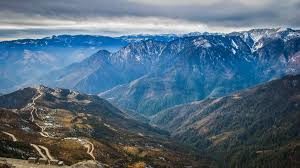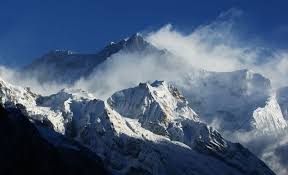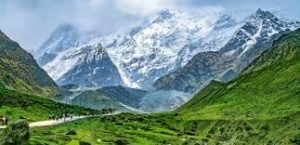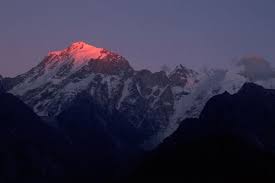Misty Mountains

Awareness
Mountains are the place, a traveller visits for adventure, escape, relaxation, leisure closer to the nature. Mountains provide serene, cold, chilling atmosphere far away from the maddening crowds along with their diverse flora and fauna.
Adventurous traveller prefers trekking and hiking, while others find solace staying closer to nature. The view of misty ice-capped mountains is a treat to the eyes as well.
Mountains are cold and chilling in winter and having a soothing climate during other parts of the year. The roads through mountains may not always be smooth and at times are bumpy and filled with other obstacles. Frequent landslides may block the roads to mountains during rainy season; hence these factors must be taken into consideration while planning a trip to mountains.
A traveller going into high altitude need to be physically fit as the oxygen level drops with increase in altitude. The traveller must carry medical kit containing necessary medicines as finding a medical shop may be difficult. They need to carry warm clothes, like gloves, thermals, mufflers, jackets and few pairs of warm socks along with ankle-high shoes that provide ample grip during ascending or descending a mountainous slope.
Weather changes suddenly in the mountains, with sudden clouds formations, it gets dark quickly when the sunsets. The availability of vehicles decreases during dark with a decrease in temperatures, hence it is preferable to visit nearby places during daytime and relax during the night.
Travelling to the mountains should be avoided during monsoon. Sudden flash floods and landslide can occur during this season blocking roads and can disrupt your travel itinerary. The roads become muddy and slippery. Those travellers who brave rains get to see the true beauty of nature with waterfalls at their full flow.
Trip Planning
Steps for preparing travel itinerary.
- Start planning your trip at least 3 – 4 months in advance. The earlier you start the better for you. In case of an international holiday, start planning about 6 months before departure.
- Planning a travel itinerary always start with the selection of destination. Depending on the duration of the trip, a traveller can select single or multiple destinations based on trip duration. In case of selecting multiple destinations, it is advisable to select other nearby destinations to the main destination. Travelling long distances is tiresome; hence traveller should select a destination that can be reached within 4-5 hours max from your current destination helps in keeping the traveller fresh.
- After selecting your destinations, chalk out your duration of stay at the selected destination. The duration of stay at a destination depends upon the following factors
- Places of interest near the destination that a traveller intends to visit.
- Ample time for relaxation and enjoying the beauty of nature.
- Time for shopping, and spending quality time with other members.
This planning helps in preparing the travel itinerary that has destinations, duration of stay and things to do.
- Once the travel itinerary is ready, preparation of budget plays an important part. The following factors are required to be considered while preparing a budget.
- The cost to reach the place of destination and return. It can be flight, railways or by road.
- The cost of rooms of hotel suiting to the comfort level of the traveller.
- The cost of daily refreshments along with the cost of mineral water.
- The cost and the means of local transportation available for travelling.
- The cost allocated for shopping and memorabilia.
- The cost for rides, gate fees, entry fees as required along with the cost of other entertainments.
- 10% of the budget allocation should always be kept for emergencies.
- Once the budget is ready, provide a nice thought and check whether the funds are available, or else some alterations are required in the travel itinerary or it may so happen that some destinations have to be dropped altogether. It may also happen that new destinations could be added based on your budget.
- Once the travel itinerary and budget are prepared. Start booking your flight or railways ticket to the destination or the nearest place to the destination. This is the reason the more advance your travel itinerary is prepared the better as you stand a good chance of confirmed reservation can also avail discounts in bookings. Always book the return tickets also well in advance. Traveller can select the timings of travel based on availed bookings.
- Once the travel itinerary is ready, preparation of budget plays an important part. The following factors are required to be considered while preparing a budget.
- Once the booking for reaching the destinations are done, next comes booking of hotels. Select a hotel that suits the traveller requirement and comfort level and budget and can book a hotel online. Here are some tips for hotel bookings that you can find in the hotel’s website.
- Obtain the Check-In and Check-Out time of your preferred hotel, and verify whether that matches with your arrival and departure. If the traveller arrives early then it depends upon the hotel criteria for early Check-In.
- The distance of travel to the hotel and its location from the airport or station. Does the hotel provide pick up and drop facility etc?
- Are the cost of meals included in the hotel tariff, what are the other amenities provided by the hotel.
- Does the hotel have ample parking space available for the traveller who likes to travel in his owned or rented vehicle?
- Are the rooms and the view as per your likings?
- Location of hotel and travel distance from the city hub. This may be very important criteria for the traveller who wants to relax far away from sounds of traffic, but on the other hand, some travellers love to live near happening places and want their hotel to be in walking distance from the place of their liking.
- Do not go by the tariff displayed at the hotel’s website. It is always better to send a mail to the hotel providing your dates and ask for the tariff, or one can simply give a call to the hotel. Once a reply is received, the traveller can compare the prices for the same hotel available online and can do the booking after comparison.
- Availability of Wifi in the hotel campus.
- Availability of doctor on call, laundry, room service are some of the features a traveller loves in the hotel.
- Availability of kids’ area, lounge, swimming pool, gym, garden etc.
- Once the booking for reaching the destinations are done, next comes booking of hotels. Select a hotel that suits the traveller requirement and comfort level and budget and can book a hotel online. Here are some tips for hotel bookings that you can find in the hotel’s website.
- Obtain information about local means of transportation for visiting nearby places.
- Always remember a proper travel itinerary with all the details and carry your original identity proof documents that help in enjoying your travel trip.
- Obtain the number of emergency services around the destination in case one requires it.
- Travellers who love trekking, the trekking routes should be chalked out in advance. It is preferable to talk to local travel agents who arrange for these treks as they take care of all the arrangements and make your trek a memorable one.
Mountains in India
Indian States With Mountains
Arunachal Pradesh
Arunachal Pradesh borders the states of Assam and Nagaland to the south and shares international borders with Bhutan in the west, Myanmar in the east and is separated from China in the north by the McMahon Line. Itanagar is the capital of the state.
This state is home to picturesque mountains, unexplored passes, amazing lakes and famous monasteries. Snow Capped Mountains, glaciers, meadows and tropical forests…
Sikkim
Sikkim is a landlocked Indian state located in the Himalayan Mountains. The state shares its borders with Nepal to the west, China’s Tibet Autonomous Region to the north and east, and Bhutan to the east. The Indian state of West Bengal lies to the south with Gangtok as its capital.
This state provides breathtaking views of the Himalayan range. It is a mystical wonderland of spectacular natural beauty. A rich scent of flower-bedecked meadows …
Uttarakhand
Uttarakhand is known as Devbhoomi, the land of gods. Nested in the lap of the Himalayas, Uttarakhand is a beautiful northern state of India that enthrals everyone with its spectacularly scenic landscapes. Surrounded by states of Himachal Pradesh in the west and Uttar Pradesh in the south and shares its international boundary with Nepal.
Filled with snow-capped peaks, quaint villages along the winding mountain roads, serpentine rivers that carve its way through the hills.
Himachal Pradesh
Himachal Pradesh is one of the most picturesque northern state sharing its boundary with states of Jammu and Kashmir in the north, Punjab in the west to Uttrakhand in the south with Shimla as its capital.
This state is an ideal destination for nature lovers, honeymoon seekers, adventure lovers, history buffs and pilgrimages along with trekkers. This state is filled with snow-capped mountains, scenic landscapes…




 (1 votes, average: 5.00 out of 5)
(1 votes, average: 5.00 out of 5)



